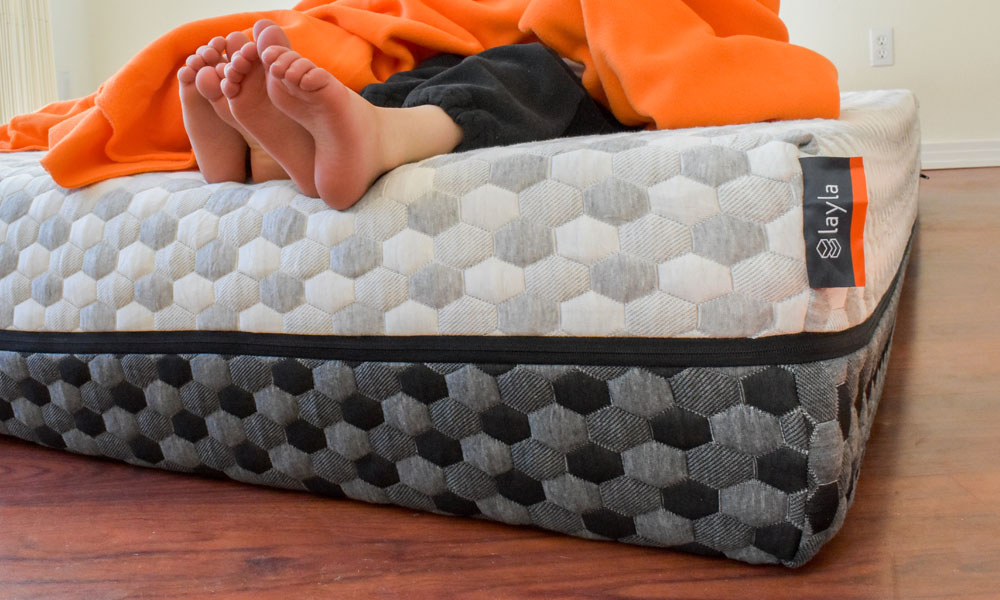There are lots of bedding systems on the market. And the battle of memory foam vs. spring mattresses is ongoing. Which type of mattress is right for you? Does it really matter what’s on the inside of your mattress? Whether you get a foam or spring mattress, doing some research never hurts.
Let’s explore memory foam vs. spring technology so you can make an informed decision about how to usher in a new era of peaceful sleep.
Memory Foam Mattresses
It wasn’t that long ago that memory foam was considered a new-fangled thing. Though the foam has been around for quite a while (it was developed in the 1960s for NASA), memory foam was considered a luxury until very recently. Don’t get us wrong, sleeping on memory foam is still a luxe experience: It doesn’t cost like one anymore.
You might even say memory foam is the new standard.
Let’s talk about what’s inside memory foam mattresses, why it might be for you, and how to make sure you don’t get bamboozled into spending money on sub-par foam.
What’s Inside
Memory foam used to be created by adding water, halocarbons, or hydrocarbons to a polyurethane mix. This created the polyurethane foam base. Nowadays, polyol is mixed with a diisocyanate and water to create the airy foam used for your memory foam bed. Is that enough science for you?
The bottom line: memory foam is specifically engineered to have a more open cell structure. This type of design does a few things. It allows the foam to be airier (so it keeps you cool) while bouncing back every time you get out of bed. Yes, please.
Now, older models of memory foam were often one big layer of foam – and some companies still make foam mattresses this way. However, most memory foam mattresses have multiple layers of different types of foam.
Layers may range from thick copper-infused foam to thin, firm foam. When combined, they create a bed that stays cool while offering evenly distributed support.
Pros and Cons of Memory Foam Mattresses
In the debate of memory foam vs. spring mattresses, there are points to be made on all sides. If you need a short list of the benefits and potential pitfalls of memory foam, we’ve got you covered.
Pros:
- Memory foam fully contours to your body shape. No matter your weight or size, the foam will change itself to hug your curves.
- Foam can bring real pain relief. Because it conforms to your specific needs, your pain points are treated more tenderly than usual.
- Memory foam mattresses have a long lifespan. Since they don’t droop over time, you can usually get more life out of a memory foam mattress than a spring one.
- Quality foam pulls heat away. Copper-infused memory foam will serve as a type of heat magnet, pulling excess heat away from your body as you sleep.
Cons:
- Bad memory foam can be hot. If you buy a low-quality memory foam mattress, you may notice your heat is not drawn away, but rather stays near the top.
- It can take time to adjust to foam. If you’ve been sleeping on a spring mattress your whole life, it might take a few weeks to get used to the different feel and support of foam.
How to Get the Most for Your Money
In the case of memory foam vs. spring mattress, how do you make sure you’re not guilty of paying too much for your new bed set?
You deserve to get the most bang (and sleep) for your buck. When you’re shopping memory foam mattresses, keep an eye out for these features that guarantee value:
- Cooling properties. Your memory foam should be able to wick heat away from your sleeping body. Copper, for instance, is very conductive. Look for a memory foam that is infused with an agent that actively works to keep you cool.
- Firmness options. Memory foam, like spring mattresses, is available in varying firmness. Depending on your pain points and the way you sleep (side, back, stomach), you may want a super firm mattress or you could need a little more give. A flippable memory foam mattress with differing firmness is a great solution.
- Foam density. Memory foam density is vital to your search for the perfect mattress. Foams come in different densities and they are not all created equal. The higher the density, the better the foam and the longer your mattress will last. With foam densities ranging from 1.0 lb and up, it is best practice to look for a density of 3.0 lb and higher to ensure you are getting the best bang for your buck.
Spring Mattresses
Innerspring mattresses are affordable, and that’s made them popular for a long time. That and the fact that sleeper creatures of habit just replace their mattress with a similar model every decade or so.
However, some people might argue spring mattresses are being phased out.
When it comes to memory foam vs. spring mattress models, spring mattresses are either considered tried and true or outdated and clumsy.
If you’re thinking of sticking with a traditional mattress, there are things you should know. Here’s a look at the inside of innerspring mattresses and a few pros and cons.
What’s Inside
You already knew spring mattresses have metal coils inside. But wait, there’s more! You’re not just sleeping on a crop of springs with no cushion. That would be pretty unbearable to say the least (like, maybe worse than sleeping on wooden crates).
Good news: a spring mattress usually has more layers than your Aunt Barb’s bean dip. The top layer is often comprised of some sort of breathable cover, followed by a layer of foam. Then, the mattress may have a layer of felt or wool (or both) before the springs.
Sometimes the coils are connected (innerspring) and sometimes they are individually wrapped (pocketed coil).
The amount of bounce in a spring mattress depends in part on how many layers of coils it has. You can go for a double layer (coil on coil), which can better distribute your body weight but have less bounce. Or, stick with a single layer of springs for a mattress with a little more give and bounce.
Pros and Cons of Spring Mattresses
Memory foam vs. spring coils… still not sure? Let’s break down some of the reasons a coil mattress might speak to your snoozing style and a few reasons you might want to slowly back away.
Pros:
- Spring mattresses can be very affordable. If you’re on a tight budget, a low-cost spring mattress with a memory foam topper can give you the best of both worlds without spending too much.
- Your spring mattress may have a shorter breaking in period. If you want a mattress that feels as good as it’s going to get right away – a spring model will give you the instant gratification you crave.
- Mattresses with inner coils have a built-in ventilation system. For people who sleep super-hot (and don’t want to), a spring mattress has historically been a good option.
Cons:
- You don’t get the benefit of contouring with spring models. If there’s one clear winner in the battle of memory foam vs. spring mattresses, it’s that foam conforms to your body. On the losing side, the nature of spring mattresses doesn’t allow the materials to hug your figure the same way.
- A spring mattress will probably need replacement sooner. Because certain points of your body (including hips and shoulders) will put more pressure on the mattress, an innerspring or pocketed spring mattress will droop in some areas over time.
How to Get the Most for Your Money
What’s that you say? Still going with springs? Look for these signs that you’re getting a spring mattress you won’t hate:
- Foam layers. If you’re going with a spring core, an upper layer of quality foam will soften the experience. Or, go with a copper-infused memory foam topper that will conform to your curves.
- Proper support. Most spring mattresses recommend a box spring foundation. Don’t skimp on the support for a spring-style mattress. You’ll need it so it doesn’t sag even more.
- Long warranty. Every mattress should have a great warranty. Given their propensity of drooping in the middle and the potential for broken springs – coil mattresses should be covered by an especially robust warranty/protection plan.
Conclusion
In the case of memory foam vs. spring, we think the answer is clear. New age memory foam can draw heat away from your torso as it cradles your hips and allows for air circulation. We call that a triple threat. Memory foam can lead to pain relief and better sleep. Suddenly you won’t be able to blame your tardiness on oversleeping. Maybe your boss will believe your car battery died again and ignore that look in your eye that says “I got in an early Netflix binge to start the day.”
Ready to get a new mattress for back pain? The Layla Mattress is a great mattress for side sleepers, back sleepers, and the rare few who sleep in downward dog (we know you’re out there). Compare mattresses – like Layla’s Hybrid Mattress vs Memory Foam – and shop for your new Layla bed today, and you’ll be winning the war on insomnia soon.



